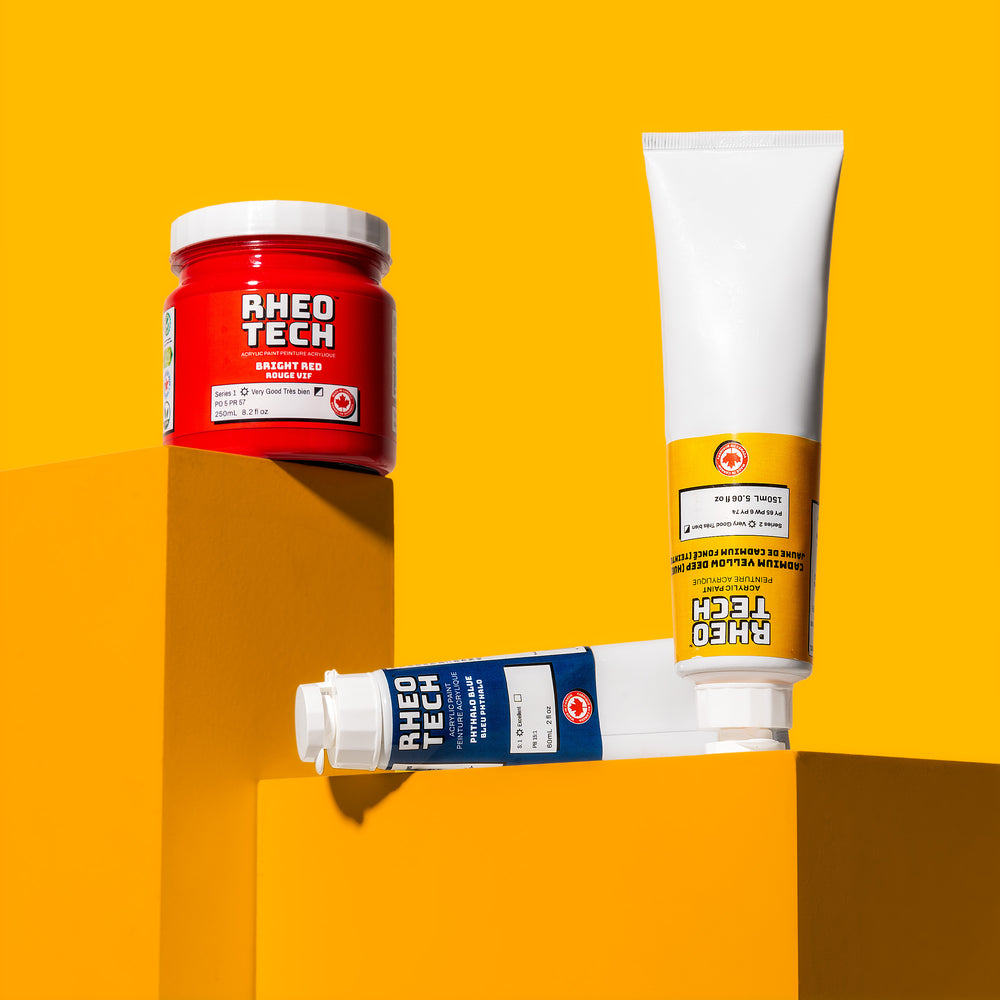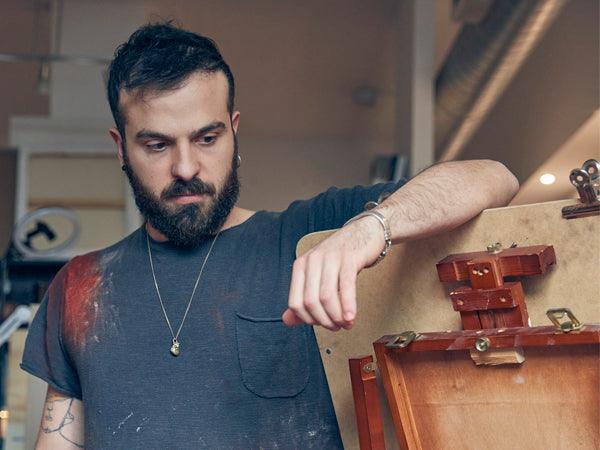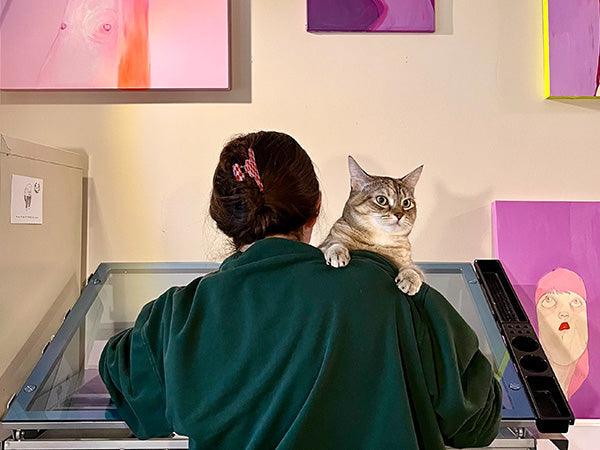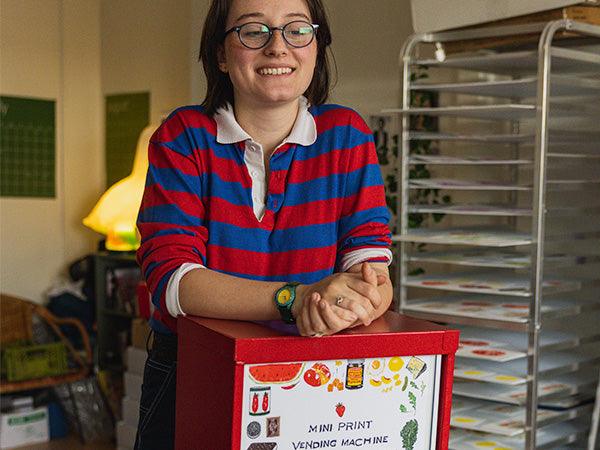“When it comes to emotions, I want to break down those false beliefs that society teaches us and start to paint an internal emotional landscape. I embrace both of our energies and emotions, both female and male. I aim to create a dialogue between the adult self and the inner child, by blending elements of figurative and abstract art.”

Introducing Fabrizio Sclocco: To kick things off, could you share a bit about your background? Where are you from and how did you find yourself on the path of artistic expression?
I was born in Pescara, Italy in 1989. Pescara is a small town on the Adriatic Sea. Surely I can say that I have always looked for something outside the box and I have always felt living in Italy was stagnant due to lack of opportunities and regressive way of thinking. I studied Architecture in Pescara, but due to lack of stimulation, I dropped out to move here in 2012 when I was 22. I decided to go on my own journey. I wanted to explore what was outside of the box since the world seemed to be a very tight space for me both in the city and my family situation.

From Childhood to Canvas: We often find that childhood experiences shape our creative journey. How do your early encounters with art influence the work you create today, especially as you've moved from Italy to Canada?
Even though I have always wanted to pursue Fine Art School, I am a self taught artist. I used to sketch since I was 3 or 4 years old, on card-stock inside stocking packages that my mother would give me when she would take me with her on her daily errands.
Moving here, I had to find whatever was available in terms of jobs and just surviving which made me put everything else aside. In 2019 I started to realize that I have to fulfill my own passions though.
When COVID hit, I was able to practice and focus more on my own art despite the trying circumstances. Though I had been living in Italy for 22 years, when I moved here, I just thought I wanted a change. I feel like when you detach yourself from what is familiar, from you country perhaps, it’s because you're wanting something different; yet, you start to feel even more drawn to what you used to see in your childhood and to your background. Maybe it even becomes more intense… So, that was my inspiration when I started to paint again.


Unveiling Your Artistic Realm: Your artworks resonate with a distinct essence. Could you delve into the realms you explore through your art, and shed light on the creative process that brings these visions to life?
"I started to extrapolate and deconstruct all of these elements, twisting them in my own way."
Through figures and symbols, my paintings explore identity amidst social disorder using theatrical sculpture-like figures and symbolic elements, to depict masks and inner trauma.
When I moved and started painting, I was doing a lot of abstract work, in my bachelor apartment, having some paintings drying on top of my bed and others on my sofa. I was playing a lot with black on black, glossy against matte finishes. Even though people liked my first paintings, I wasn't really connecting with them. It was a bit out of character and felt absent. There are amazing abstract artists out there, which I'm continually inspired by, but seems to me that some people go towards making abstract art, because
it sells.
Years later I moved to Toronto, I somewhat circled back to Architecture when I established myself as Set Designer in the Film Industry for the Directors Guild of Canada. This position made me feel inspired and seen for who I wanted to be seen as, a designer and creator, where my knowledge and profession was finally respected and retributed as so. In this time of my life, I was traveling along Croatia, Italy and Spain. I started to represent the timeless and rich cultural tapestry and landscapes that defines the Mediterranean, with its beauty, its traditions and its flavours. I was combining art and architecture and I started to extrapolate and deconstruct all of these elements, twisting them in my own way. I never took painting lessons, but I could sketch my ideas. I was able to challenge myself and start to explore a bit with acrylic and then oil. Now I rarely sketch; maybe I should sketch more.
I just jump on the painting.


Reimagining Renaissance: It's intriguing how you pay homage to the Renaissance era while infusing your own commentary. Can you elaborate on your process of reinterpreting classic themes to make a contemporary artistic statement?

While I was traveling in Italy I was taking note of parts of my background, the places where I used to go all the time. I would see these old monuments and important artists and be inspired to use those figures, once again. But I would use them and the styles to symbolize the society we are in right now too.
And that's how I pay homage.
Identity and Healing: Your art seems to touch upon the theme of identity and healing. Can you expand on how these concepts intertwine in your creations, and the emotions you aim to evoke through your work?
Finding who we are, what we need, what fulfills us not only in a few years but in our daily routine... we're not good at that, the answer is not as easy as we think it is. That’s when I think about identity and healing. If I were to ask someone to describe their identity, sometimes they kind of go into a defensive mode - it’s uncomfortable to walk through at length.
When it comes to emotions, I want to break down those false beliefs that society teaches us and start to paint an internal emotional landscape. I use metaphors of planes and pedestals as self embracing and self fulfilment; I use arches as symbols of space of gathering to self healing. I embrace both of our energies and emotions, both female and male. For example, there's a painting called “The Embrace”, where I show a male figure hugging the body of a woman. This body of a woman is sort of sheltered and hugged by the man. The male figure is basically and finally trying to explore the other side of themselves, which is the female side.

Navigating Mental Terrain: You have described your journey from Italy to Canada as an intricate blend of emotions. How did this transition impact your mental well-being, and how does it influence your art's exploration of emotional states?
The emotional toll as an immigrant, particularly in my early years in Canada, made me question many aspect of my identity accentuated by new customs, a language barrier that often turned down opportunities, or made me more vulnerable in situation where I was on the receiving end of micro-aggressions and racial slurs. I felt a sense of being emotionally and psychologically disconnected.
Though Toronto is a vibrant and thriving multicultural city with an incredible food scene and events all the time, I often found myself in scenarios of full social isolation. Working on four different part times jobs, countless sacrifices, and extreme overthinking, I was introduced to post-landing depression by my doctor in my third year of living in Canada. I recognized the same characteristics by feelings of sadness, nostalgia, and a sense of disconnection from the world I had around. I used to numb these feelings of discomfort with the abuse of alcohol which it used to get me in to trouble at work.
When I travel to countries with ancient architecture, I am intrigued by their beauty. For example, I am fascinated by the decay of tiles and frescoes that creates a pattern against the patches of plaster. I see them as a cluster of broken forms with negative space around them, yet they creates scene where they embrace each other. Same applies to my paintings, I deconstructed the forms, the bodies and I isolated them. My therapist suggested that maybe these forms are speaking to the isolation that I had felt when I moved to Canada; this interruption of relationships I lived through for a while.
Whether it’s trauma or nostalgia - that's what this part represents. The almost sculpture - like figures in my paintings are hollow - a metaphor for a traumatized inner self. This is what identity is made of. Through the use of harsh light and shadows, I cast a light on the void space inside and around the figures, symbolizing a hidden wound, and the overall loneliness of my subjects.
I think we are very open when we are a child, but then there is something that happens - society kicks in, and there are so many expectations, judgments, and that can shape you in a different way, for both women and men. It's very distracting for us. We lose sight of our primary needs. We don't really know ourselves and what we are capable of. That’s basically why I show both sides in my work.

"Through the use of harsh light and shadows, I cast a light on the void space inside and around the figures, symbolizing a hidden wound, and the overall loneliness of my subjects."
Intricate Symbolism: Your use of symbolism is captivating, from broken masks to severed forms. Could you unravel the significance of these motifs and how they tie into the narratives within your art?
The severed figures are basically like the armour that we put on everyday. I never show a face on top of the body. They are two separate ideas. Inspired by ancient word, the masks speak to more of a logical process, and at the same time they are a symbol of their literal use, the figurative masks that we put on every day. The severed bodies are symbols of emotional process. On them, if you look closer, you can see they are pale or bruised like they went through something, if they have had their past. This is what identity is made of.

Empowering Vulnerability: It's noteworthy how your art contributes to promoting vulnerability, particularly among men. Could you share more about your mission to raise awareness and inspire openness in this regard?
Let’s take the glove of pearls I represents in my paintings. If you consider the structure of how the glove is actually built, a mesh of threads to hold the pearls or “everything together”, it somewhat feels confining. That's how society is trying to shape you and wear these gloves. Or it’s the feeling of suffocating - it's a mix of
both. It’s those things we wear as humans.
Most of the time, especially in some societies, men are not really allowed to dive into this water where they show their vulnerability. They seem as weak if they do and there is such a pressure from society to be a certain way, right? People aren't always accepted for who they are and/or were and that’s what I want to talk about in my work.
It's interesting to see lots of men coming up to me to thank me. I love the interpretation from other people. They get it. I'm talking about men, you know, that are married and in their fifties with kids and everything, and they come to me saying “thank you so much”. I feel like there is that part in some of these men that want to come back to look. They come up to me and we talk and it's actually quite interesting to see that response.
When you respond that way I feel like you're not just approaching the art, you’re kind of approaching yourself a little bit too.

Lastly, what's on the horizon for Fabrizio Sclocco? Are there current collaborations or upcoming projects that you'd like to share with us, giving us a glimpse into your artistic evolution?
Right now I am part of an exhibit alongside Omar Saenz at The Station Independent
Project in Toronto by Leah Oates. The exhibit will be up until November 18th.
I am currently applying to galleries, in Toronto and abroad. I am one of the featured artists at the Art Gallery of Ontario in Toronto and recently, my works have been showcased at the Four Seasons Hotel in Mexico City, The Artist Project and at the Columbus Centre in Toronto, and at the Centurion Lounge in New York
Also, I am always busy working in American productions, TV shows and movies, as a Set Designer for the Directors Guild of Canada. Since I was a kid, I was always fascinated by the behind the scenes of movies. I love how the two careers blends in one another.
I am a big believer in dreams, and goals are important for us so for myself my goals are to exhibit in big city with remarkable art scene such as Paris, New York, and Miami at Art Basel, why not? I also would love to translate my artwork in a line of interior decor at some point. Success is not final, failure is not fatal: It is the courage to continue that counts.
"Believe in yourself and never give in."






